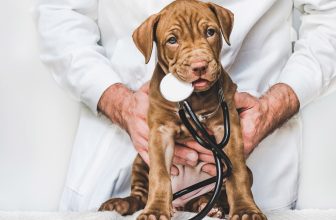
Desensitizing a Dog to High-Pitched Beeps: Part 2 of 2
Please read Part 1 of this two-part series before this one, Part 2!
Part 2 recounts an informal case study I did when I applied the concepts I discussed in Part 1. To desensitize and countercondition my dog Zani to electronic beeps, I started with a low frequency that didn’t scare her and worked up to the original frequency. I did this rather than starting with a quieter beep since the beeps were already quiet and still scared her. I also adjusted the duration as part of the process.
Case Study: Successful DS/CC Using Frequency and Duration to Modify the Trigger Sound
Zani was a small hound and terrier mix, about 20 pounds. She was fun, clever, and feisty enough to stand up to the bigger dogs in the house. I got her in 2009 at about a year old; she passed away from lymphoma in the fall of 2020.
Zani was sensitive to sounds. As she got older, this worsened, and she was diagnosed with clinical sound phobia by a veterinary behaviorist. Zani was afraid of digital beeps, whistles, the squeak of sports shoes on a slick floor, and, at her worst, some bird calls.
One sound she feared was the beep of a new bathroom scale. This is the sound whose waveform I showed in Part 1. The beep was 0.15 seconds long and 3900 Hz. It was almost the same frequency as my dishwasher beep, which, interestingly, didn’t bother her. Also, the previous bathroom scale, which beeped at a different frequency, didn’t bother her. But the new one sure did. I noted the dishwasher beep was 1.4 seconds, so the sound of the scale was much shorter. Both these sounds were quiet, so I guessed that volume wasn’t the problem. And when volume isn’t the problem, making a quieter version won’t necessarily help. A quiet sound could even be scarier, as I suggested in the previous post.
I created a series of digital sounds to condition Zani to the bathroom scale beep. I started with a lower frequency beep that didn’t scare her and gradually raised it, doing the cleanest counterconditioning I knew how to do. When I first reached the original frequency, I made the sounds longer, then shortened them again as a last step. So in the desensitization sound series, I varied both those qualities—frequency and duration—to work back to the original, formerly-scary sound.
Again, the trigger sound was 3900 Hz and 0.15 seconds. Here is a list of the sounds I created for desensitization to work up to the original sound. I used the software Audacity to create and modify the sounds.
| Sound # | Pitch | Duration |
|---|---|---|
| 1 | 1950 Hz | 0.2 sec |
| 2 | 2112 Hz | 0.2 sec |
| 3 | 2275 Hz | 0.2 sec |
| 4 | 2437 Hz | 0.2 sec |
| 5 | 3150 Hz | 0.2 sec |
| 6 | 3900 Hz | 1.0 sec |
| 7 | 3900 Hz | 0.8 sec |
| 8 | 3900 Hz | 0.6 sec |
| 9 | 3900 Hz | 0.4 sec |
| 10 | 3900 Hz | 0.2 sec |
| 11 | 3900 Hz | 0.1 sec |
Creating a Clean Pairing
The chart above shows the desensitization series. The counterconditioning part was that every sound was immediately followed by food that Zani loved.
To create a clean pairing between the sound and the food, I needed to be sure there weren’t any other predictors of her getting to eat it. I made sure none of the following predicted her getting the food:
- Opening the refrigerator and getting out the food
- The food sitting on a counter
- My location in the house
- Setting up or turning on the audio speaker
- The presence of my laptop
- The time of day
- Setting up a video camera and filming
This ruled out the common practice of getting out some food, turning on a camera, sitting down with the dog close to a speaker with a plate of the food or a treat bag, and doing multiple exposures. I worked to make every single exposure a surprise.
The item that took the most work was the food. Dogs usually know we are going to do something with them because we go to the refrigerator and prepare food or get out our treat bag. To make the special food a non-predictor, I got it out every day for several days and set it in a dish on the counter (out of reach of the dogs). I did this before I ever did a sound exposure. I continued to get it out every day, whether or not I was doing an exposure. The goal was for the odor of the food (and the act of me getting it out) not to predict Zani getting to eat the food.
The other thing that took the most planning was to be sure that I wasn’t always sitting at my computer the moment the sound happened. Sometimes I was, but usually I was moving around the room. I hit the play button on my computer and sent the sound wirelessly to a speaker. (Nowadays I use a handheld device—dogs see us carry these around and look at them and poke at them all the time.) I included several seconds of lead time at the beginning of each sound recording so I could press the “play” button but then do a random activity.
Camera recording on a tripod could also be a big tell. I had to have the tripod with a phone on it sitting around a lot and turn the video on and off randomly during the day. I was always careful to start the video for the actual exposure way early. That would give me minutes of unimportant footage to trim off (not included in the video).
I did a maximum of two single exposures per day, usually just one, and not every day.
When I first tested my base sound to make sure it didn’t scare Zani, I treated it as a planned exposure. I did all the above, including doing food odor exposures for a couple of days beforehand. And of course she got her special treat after I played the test sound.
All the exposures I show on the video are in my kitchen. That’s because filming was easiest there. I did exposures in other parts of the house as well. Also, the dogs often act like they are waiting for something to happen. That was typical “kitchen” behavior. When I was working in the kitchen or sitting at the table, they hung out on their mats. Their attention to me was not necessarily tied to expecting a sound exposure. I think I did a decent job of reducing predictors. You can see their physical response, often a moderate startle, when the sound plays.
What I’d Do Differently Now
Zani’s conditioning was successful. But I’ve learned enough since then that I could make it even less risky. The technical part seems pretty crude to me, now.
The first sound I created for her series was one octave below the trigger: 1950 Hz compared to 3900 Hz. Exactly half the frequency. I now choose sounds to begin with that are less mathematically related. Sounds an octave apart sound similar, and the goal is to start with something not very similar.
For most dogs, I would now fade the sound in for the early reps, rather than having those harsh attacks. That could be more effective than tinkering with the duration.
I was surprised when looking over the videos to see that I used at least two different foods. I don’t do that now. I do know that all the food I used was very high value for her, even the couple of crunchy ones, which were probably Lakse Kronch fish treats.
A difficult question was how many reps to perform for each individual sound. The science around classical conditioning tells us we get our best conditioning in the first repetitions. Do we think of each single sound as one thing being conditioned or think of the series as a unit? I was conservative with my repetitions and did only a couple at each level. I didn’t try to get straight to “I love this” on the first sound; I went ahead when Zani said something more like, “This is interesting; where’s my treat?” That strategy worked, but there may have been some luck involved.
In the Poppen study (1970), it usually took the rats 5–10 repetitions at each frequency to recover from the fear conditioning. Also, it took more repetitions as the frequency approached the original. I didn’t do more repetitions deliberately (I hadn’t read the study then), but my sound series had a similar effect with the last frequency being presented at different durations. Hence, there were more repetitions.
Generalization
People with good pitch memory will notice that the beep of the oven control in the DS/CC video is not the same pitch as the beep of the bathroom scale. That’s good news about the pitch difference. The initial counterconditioning spread to all beeps. I ad hoc counterconditioned any high-pitched noise that happened when I was with her. With this practice added to the formal desensitization and counterconditioning, Zani recovered from her fear.
I continued to treat for these sounds for the rest of her life to keep the pairing strong. The stakes were too high to mess around with it, especially since life provided some sounds I couldn’t do anything about.
Cautions
- Zani was under the care of a veterinary behaviorist. She instructed me to wait until Zani was stable on her meds and I did so.
- I had excellent advice from some professional trainers.
- I had lived long enough with a sound phobic dog that I knew to be very, very careful. Every exposure was a risk.
One more success: Zani was happy to get on the same scale, beeps and all, to get weighed for the rest of her life. The footage is at the end of the video embedded above.

My Quandary
For a few years now, I have quietly worked with clients with sound phobic dogs by creating custom sound series. I required the collaboration of a credentialed behavior specialist since my work was only from the acoustics side. Despite some modest successes, I have stopped providing this service. Virtually every dog who came to me had already generalized their fears such that we always had to deal with a new scary sound. A sad game of whack-a-mole. (The sounds the dogs got sensitized to were less alike than beeps. An example would be a dog who is bothered by the sound of the engines of certain delivery trucks then getting sensitized to the backing-up sound or the puff of the brakes.) For these dogs, conditioning one sound didn’t “erase” the problems with the others. Most of the dogs were on medications, by the way.
I believe this information should be freely available, hence this pair of posts. But I worry that it will lead to more people scaring their dogs by tinkering with sounds without expert help from a behavior professional. (Of course, people already do that with various “desensitization” sound apps.) I considered the idea of creating an app or a membership program, but the administrative work necessary for that would not be possible for me.
My compromise is that I may publish a few “off-the-shelf” sound series (e.g., an electronic beep, an explosive pop, and the smoke alarm low battery noise). I’ll softly gatekeep them by requiring users to sign a disclaimer and convince me they will follow good practices before accessing. If I charge at all, they will be reasonably priced.
For now I’m putting this concept into the public domain. Please be careful. And I hope to see some beautiful successes.
Related Posts
References
Poppen, R. (1970). Counterconditioning of Conditioned Suppression in Rats. Psychological Reports, 27(2), 659–671.
Copyright 2023 Eileen Anderson
creditSource link






